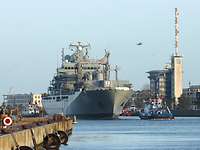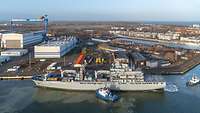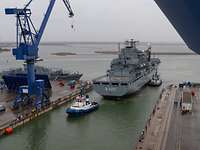Biggest Navy vessel in the Warnowwerft shipyard
On 05 February 2024 the combat support ship Bonn arrived at the Warnowwerft shipyard for an unscheduled repair. The shipyard team in Rostock-Warnemünde is taking up the challenge.



On 05 February 2024 the combat support ship Bonn arrived at the Warnowwerft shipyard for an unscheduled repair. The shipyard team in Rostock-Warnemünde is taking up the challenge.

Unscheduled? Since 15 January of this year, the combat support ship Bonn has taken part in a NATONorth Atlantic Treaty Organization mission on the Baltic Sea. However, the deployment had to be interrupted: Due to damage to the propulsion of the replenishment ship, repairs became unavoidable.
A special moment: The biggest Navy vessel reaches the shipyard
After the decision to repair the damage while the operation was ongoing and to perform the repair at the Warnowwerft shipyard, which belongs to the Wilhelmshaven Naval Arsenal, the fuel the ship was carrying had to be stored elsewhere. But what to do with five million liters of diesel fuel? The most obvious answer was the fuel tanker Spessart at the Kiel naval base: therefore, it was quickly decided to use it as an interim fuel storage facility. Due to its capacity, the fuel tanker is an ideal and welcome storage location for the immense amount of fuel in this situation. The ship has been in Kiel since the beginning of 2024 to prepare for decommissioning. However, all necessary systems remain functional and operational.
Before the diesel fuel and the aviation fuel for helicopters could be pumped off board, the Schleswig-Holstein Technical Relief Agency helped and provided oil barriers. These were attached to the ships Bonn and Spessart. An important step for environmental and water protection: This prevents fuel from being released into the environment.
Subsequently, the combat support ship pumped the diesel fuel into Spessart via a 180-meter hose connection. Spessart’s civilian crew supported the project in a routine manner. After the fuel transfer, Bonn and her crew moved to Rostock-Warnemünde to the Warnowwerft shipyard.

The combat support ship Bonn entering the Warnowerft shipyard A repair was not possible at the nearest shipyard, where the sister ship Berlin is undergoing scheduled maintenance. The Solution: The shipyard specialists repair the combat support ship …
Bundeswehr/Michelle Peich
Tugs pulling the combat support ship into the dry dock
Bundeswehr/Jaquelin MohitThe dry dock is the core of the government-owned Warnowwerft and is used for the flexible and short-term repair of German Navy boats and ships. It is 320 meters long and 54 meters wide. 80 meters of the shore-side part of the dock are covered. The so-called main dock gate separates the dock from the Warnow. The interior can be subdivided into different areas via an intermediate dock gate. In this way, planned work can be carried out on the underwater area of the ships and boats in the dry shoreward part of the dock and the seaward part of the dock can be kept free for unscheduled repairs on naval vessels.
It is not only the dry dock itself that is an essential component of the Warnow shipyard. Some of the specialists employed there have decades of experience. They are thus also an important factor in the quick and efficient conduct of work on site. Their expertise is evident in every step - from guiding the ship into port until it reaches its position in the basin of the dock. The Naval Arsenal, which is based in Rostock-Warnemünde, can thus make a significant contribution to the operational capability of naval ships and boats.
The ship’s weight was reduced before docking by removing POLPetrol, Oil and Lubricants. The combat support ship Bonn now has a lower draft and is floated into dock with three tugs and then moored at the dock wall. After the tugs have left, the main dock gate is closed. Subsequently, the ship is secured with four dock winches and pulled into position above an arrangement of blocks. The ship rests on the blocks in the dry dock. The water is successively drained from the dock until the ship’s keel rests on the blocks. This procedure may take up to eight hours
As soon as all necessary work has been completed, the largest ship of the Navy can leave the shipyard and continue its operation after ten days at the shipyard. The Warnowwerft team will thus have mastered a major challenge.
It takes many hours to pump the water off.